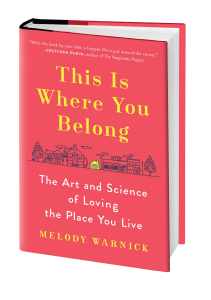
Looking for a last minute holiday gift? Or maybe just a book for yourself to enjoy during whatever holiday break you may have? I’d like to give my enthusiastic recommendation of This is Where You Belong, a recently published book by our fellow blogger, Melody Warnick. Her book, written for a general audience, offers a fantastic runway to fulfilling community engagement for any and all readers. And for the readers of this blog, particularly local government and other community-based organization practitioners, her book is full of ideas for ways that you can help make community feel like home for your constituents.
I must make a disclaimer here that that am not entirely unbiased. As mentioned, Melody is a friend and fellow blogger here at CELE. But she has not put me up to this! No, I’ve read her wonderful book and really do think that it would make a great gift to any of your friends and family that read, as well as a book you ought to put on your reading queue. Why? Here are three of my top reasons:
- It is written for a general audience. This is no dry, academic tome. Rather, it is a fun and enriching read. Melody is a great writer and this book is written in a first-person, ultra-accessible way. Her book is in the “mesearch” tradition, where she embarks on a quest to learn all she can about how people such as herself could fall in love with where they live. She does her research, yes, but she also tries out the various recommendations she finds and the reader thus vicariously experiences the value of the practices she discusses.

- While the book is ultimately about “loving where you live” or what social scientists call place attachment, the practical advice that is at the heart of the book is really a formula for how community residents can become more engaged. In other words, truly engaging community is the route to loving it. So, local government leaders, for example, may think, “what can we do to better engage citizens?” Or perhaps, “how can we get citizens (residents) to love this community, and by extension, be motivated to give back, and be actively engaged in making this a better place?” The answer to those questions can be found in This is Where You Belong. Again, the audience are regular or “normal” citizens, but when I read it, I could not help but see in virtually every recommendation a way that local governments and community organizations could play a vital role in facilitating or stimulating that kind of activity through small civic investments. Some of these investments are more obvious (consider hosting a citizens academy). Other less-so (designing communities to be walkable or assisting local food efforts).
- The practices at the heart of this book demonstrate how important everyday choices by individuals and families can connect to the broader concerns of community engagement and civic infrastructure. Where people shop, what they eat, how they spend free time, or the extent to which they interact with neighbors, all have profound effects not only their well-being, but also on the overall strength of communities as communities. Put another way, reading this book reminded me of the micro-macro link. The micro choices we make in community, day-to-day are reflected in macro observations we make about a community’s “civic health” or strength of its “civic infrastructure.”
 This is Where You Belong is one of the only books of which I am aware, for a general audience, that is all about community engagement from a “regular” citizen/resident perspective. While there is a chapter about formal ways to “get political” by following local politics more closely or attending a citizens academy or volunteering for a citizen board, for example, it also highlights that those formal, governmental forms of engagement are only one of many different ways that we connect with our communities. And that is kind of the point. There are many avenues to community engagement, and those of us who think a lot about the topic and how to strengthen our communities more generally, would be well advised to think more broadly about this wide spectrum of ways that people can engage.
This is Where You Belong is one of the only books of which I am aware, for a general audience, that is all about community engagement from a “regular” citizen/resident perspective. While there is a chapter about formal ways to “get political” by following local politics more closely or attending a citizens academy or volunteering for a citizen board, for example, it also highlights that those formal, governmental forms of engagement are only one of many different ways that we connect with our communities. And that is kind of the point. There are many avenues to community engagement, and those of us who think a lot about the topic and how to strengthen our communities more generally, would be well advised to think more broadly about this wide spectrum of ways that people can engage.
I encourage you to pick up a copy of This is Where You Belong. And perhaps get a copy or two for your friends or family! Congratulations Melody on your excellent contribution to the practice of community engagement.